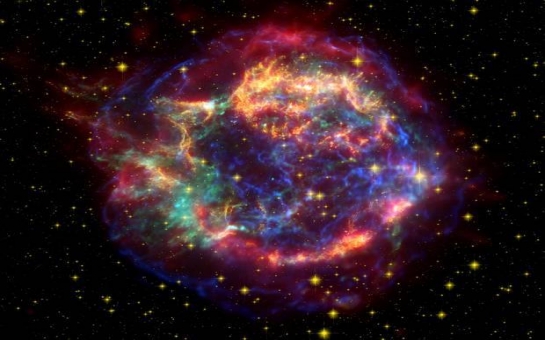Follow us !
Astronomers look deep inside a supernova for the first time
Society
17:45 | 21.02.2014

Astronomers look deep inside a supernova for the first time
For the first time ever astronomers have been able to look inside the heart of an exploding star, using a space telescope to peer into the radioactive corpse of Cassiopeia A, a star that was once eight times the size of the Sun.“This has been a holy grail observation for high energy astrophysics for decades,” said Steven Boggs, chair of physics at UC Berkeley and co-author of the paper published in the journal Nature.“For the first time we are able to image the radioactive emission in a supernova remnant, which lets us probe the fundamental physics of the nuclear explosion at the heart of the supernova like we have never been able to do before.”Supernovae are a key mechanism in the formation of the Universe as we know it, creating a wide array of ‘heavy’ elements via nucleosynthesis and ejecting this matter deep into the cosmos. In fact, the shock waves from supernovae can even trigger the formation of new stars – making these explosions part of the Universe’s most awe-inspiring ‘life cycle’."People should care about supernova explosions because that's where all the stuff that makes us comes from," Brian Grefenstette, lead author on the paper and a research scientist at the California Institute of Technology, told CNN.“All of the iron in your blood and calcium in your bones and teeth, and gold in your wedding band, that all comes from the center of a supernova explosion."However, although scientists have long known about the importance of supernovae in creating matter, they’ve been unable to get a closer look at the process that causes them to explode.Supernovae occur when stars many time the size of our Sun run out of fuel, leaving behind a dense iron core that collapses in on itself, a process that can happen at velocities reaching 70,000 km/s and that causes a shockwave, expelling gas and dust into space. We can see existing stars and supernova remnants but the moments in between are much more mysterious."It's like you blink your eyes twice, and the whole thing has exploded, and we're seeing it three or four hundred years later, preserved in the radioactive ash," said Grefenstette.This latest research used the NuSTAR telescope (short for Nuclear Spectroscopic Telescope Array) astronomers have been able to analyse a previously unexamined section of the X-ray spectrum in supernova remnant Cassiopeia A, a well-observed stellar explosion first spotted in 1947.Other telescopic arrays such as the Hubble Space Telescope and Chandra X-Ray Observatory are only capable of looking at low-energy X-ray trails from elements like iron, but the NuSTAR was able to map the movement of the high-energy element, titanium-44, within the cosmic explosion of Cassiopeia A.The observations captured by NuSTAR have led the astronomers to believe that the explosion was shaped by pressure inside the iron core of the dying star “sloshing” about; an asymmetrical process (below) that could explain why supernova remnants look so crooked compared to the spherical stars they once were.Grefenstette compares the process to the top blowing off a pressure cooker, with the subsequent shockwave tearing the matter of the star apart and leaving behind the uneven splashes and smears of matter we now see."We think that these large bubbles, which were formed in the first fraction of a second as the star collapsed, have been preserved for hundreds of years like a fossil record in the radioactive ash of the explosion," said Grefenstette, describing the trails of titanium-44 that have been newly mapped.These observations have helped astronomers rule out previous theories about how stars explode, but NuSTAR’s measurements have also raised further questions. The astronomers found that the map of titanium-44 recorded by the telescope does not match up with the map of iron created by other telescopes – even though both elements are supposed to have come from the same ‘bubbles’ of pressure.This may mean that there is simply some iron that hasn’t been detected by the telescopes (they can only observe the element when it is hot) or that there some other process within the supernova creating these elements. It is perhaps unsurprising that even when we can look within the heart of a dying star, it creates more questions than answers.(independent.co.uk)ANN.Az










